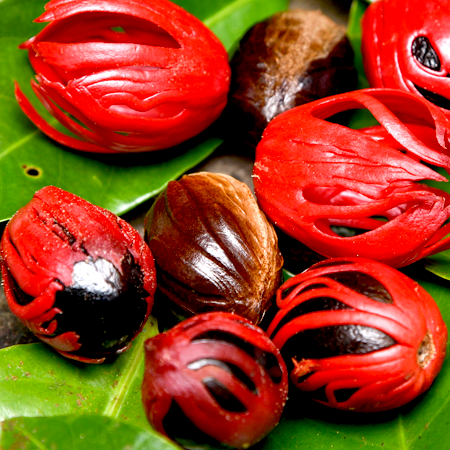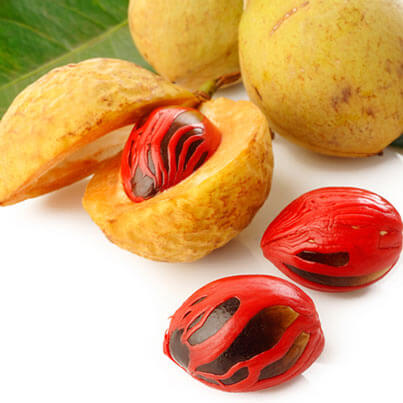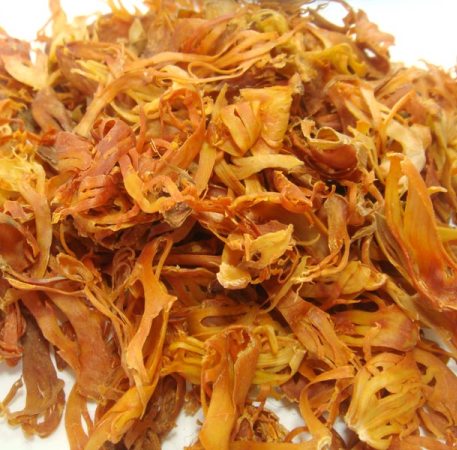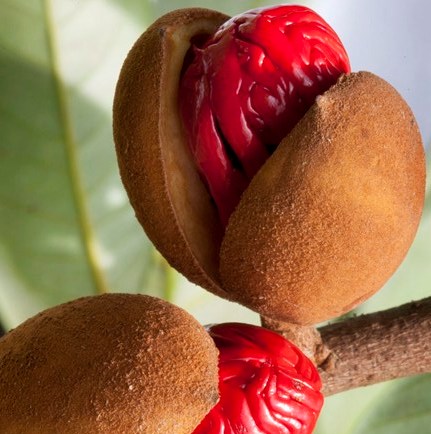




Botanical name Myristica fragrans
Family Myristicaceae
Source Aril (pericarp) which surrounds the ripe seed
Origin Sri Lanka
Processing Method Steam Distillation
Color/Consistency A thin, Colourless to slight yellow clear liquid
Aromatic Summary / Note / Strength of Aroma A middle note with a medium aroma, Mace Essential Oil has sweet, spicy scent reminiscent of nutmeg.
Blends With Lavender, Bay, Orange, Geranium, Clary Sage, Rosemary, Lime, Petitgrain, Mandarin and Coriander.
Product Abstract
The nutmeg fruit is pendulous and similar in presentation to a peach. When fully mature, it splits in two, exposing a crimson-colored aril. This is the mace which surrounds the nutmeg pit. Mace is a vibrant red-colored seed husk covering (aril). Mace Essential Oil has a history of medical use in combination with nutmeg. It has progressed over time and is added to soaps, perfumes and it is also used as a cooking ingredient. It smells like and is very close to nutmeg in its makeup.
History
Myristica fragrans is a small evergreen tree, usually 5–13 m (16–43 ft) tall, but occasionally reaching 20 m (66 ft). The alternately arranged leaves are dark green,5–15 cm (2.0–5.9 in) long by 2–7 cm (0.8–2.8 in) wide with petioles about 1 cm (0.4 in) long. The species is dioecious, i.e. "male" or staminate flowers and "female" or carpelleate flowers are borne on different plants, although occasional individuals produce both kinds of flower. The flowers are bell-shaped, pale yellow and somewhat waxy and fleshy.
Harvesting/Extraction Information
The oil is extracted from aril using steam distillation process. The oil is also added to a blend where mace oil is used as fixative. Further, its analgesic properties also make it useful for treating muscle fatigue and arthritis.
Common Usage
Caution
Dilute before use; for external use only in small doses. May cause skin irritation in some individuals; a skin test is recommended prior to use. Contact with eyes should be avoided.
Key constituents
α-Pinene 16.3–26.7%
β-Pinene 10.6–20.0%
Sabinene 12.5–14.5%
Terpinen-4-ol 4.4–14.0%
ϒ-Terpinene 4.9–11.6%
β-Phellandreneþ1,8-cineole 4.9–11.6%
(β)-Limonene 4.2–9.4%
α-Terpinene 4.8–7.5%
Myristicin 1.3–3.8%
Elemicin 0.2–2.0%
Safrole 0.2–1.9%
α-Terpineol 0.7–1.2%
Methyleugenol 0.1–0.2%
Isoeugenol 0–0.1%
Safety summary
Hazards Potentially carcinogenic, based on safrole and methyleugenol content; may be psychotropic.
Contraindications None known.
Maximum adult daily oral dose (Sri Lankan mace oil) 73 mg
Maximum adult daily oral dose (Sri Lankan mace oil) 146 mg
Maximum dermal use level (Sri Lankan mace oil)
EU 0.08%
IFRA 0.2%
Tisserand & Young 2%
Maximum dermal use level (Sri Lankanmace oil)
EU 0.1%
IFRA 0.18%
Tisserand & Young 4.1%
Our safety advice
We recommend a dermal maximum of 2% for the Sri Lankan oil and a maximum oral dose of 73 mg based on 1.9% safrole and 0.2% methyleugenol content, and a dermal maximum of 4.1% and a maximum oral dose of 146 mg for the Sri Lankan oil based on 0.7% safrole and 0.2% methyleugenol. These are based on dermal limits of 0.05% and 0.02%, and oral dose limits of 0.025 and 0.01 mg/kg for safrole and methyleugenol, respectively.
Regulatory guidelines
IFRA and the EU recommend a maximum exposure level of 0.01% of safrole from the use of safrole-containing essential oils in cosmetics. IFRA recommends a maximum concentration of 0.0004% methyleugenol in leave-on products such as body lotions (IFRA 2009). The equivalent SCCNFP maximum is 0.0002%.
Organ-specific effects
Adverse skin reactions Undiluted mace oil was moderately irritating to rabbits, but was not irritating to mice or pigs; tested at 8% on 25 volunteers it was neither irritating nor sensitizing. It is non-phototoxic (Opdyke 1979a p. 851–852).
Neurotoxicity Psychotropic effects have been reported for nutmeg in high doses. Myristicin and elemicin are thought to be responsible, but other synergistic elements may need to be present for a psychotropic effect to take place.
Systemic effects
Acute toxicity Mace oil acute oral LD50 in rats 3.64 g/kg; acute dermal LD50 in rabbits >5 g/kg (Opdyke 1979a p. 851–852).
Carcinogenic/anticarcinogenic potential: No information was found for mace oil. Safrole and methyleugenol are carcinogenic if the dose is sufficiently high; (þ)-limonene and myristicin display anticarcinogenic activity.
Comments
No compositional data was found for West Indian mace oil, but a CO2 extract contained 0.2% safrole and 0.1% methyleugenol (Lawrence 2000c p. 66–68). It is feasible that the myristicin in mace oil might counter the potentially carcinogenic effect of methyleugenol and safrole.